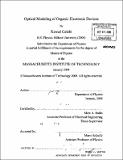Optical modeling of organic electronic devices
Author(s)
Celebi, Kemal
DownloadFull printable version (15.97Mb)
Other Contributors
Massachusetts Institute of Technology. Dept. of Physics.
Advisor
Marc A. Baldo.
Terms of use
Metadata
Show full item recordAbstract
Organic materials, with their superior photoluminescence and absorbance properties have revolutionized the technologies for displays and solar energy conversion. Due to the large transition dipoles, the localization of excited states or excitons in organic materials necessitates optical models that extend beyond classical far field methods. In this thesis we propose an extended near field calculation method using dyadic Green's functions and demonstrate the applications of both our extended model and traditional far field models for different types of devices such as surface plasmon detectors, cavity organic light emitting devices and organic photovoltaics with external antennas.
Description
Thesis (S.M.)--Massachusetts Institute of Technology, Dept. of Physics, 2008. Includes bibliographical references (p. 51-53).
Date issued
2008Department
Massachusetts Institute of Technology. Department of PhysicsPublisher
Massachusetts Institute of Technology
Keywords
Physics.